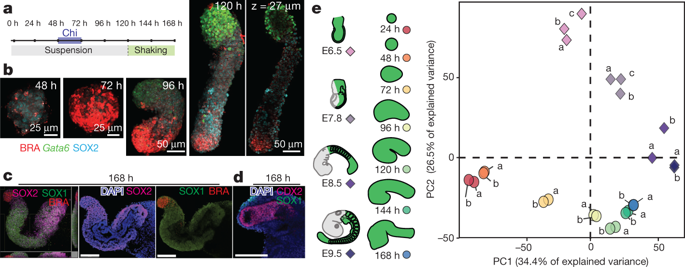Our official English website, www.x-mol.net, welcomes your
feedback! (Note: you will need to create a separate account there.)
Multi-axial self-organization properties of mouse embryonic stem cells into gastruloids
Nature ( IF 50.5 ) Pub Date : 2018-10-01 , DOI: 10.1038/s41586-018-0578-0 Leonardo Beccari 1 , Naomi Moris 2 , Mehmet Girgin 3 , David A Turner 2 , Peter Baillie-Johnson 2, 4 , Anne-Catherine Cossy 5 , Matthias P Lutolf 3 , Denis Duboule 1, 5 , Alfonso Martinez Arias 2
Nature ( IF 50.5 ) Pub Date : 2018-10-01 , DOI: 10.1038/s41586-018-0578-0 Leonardo Beccari 1 , Naomi Moris 2 , Mehmet Girgin 3 , David A Turner 2 , Peter Baillie-Johnson 2, 4 , Anne-Catherine Cossy 5 , Matthias P Lutolf 3 , Denis Duboule 1, 5 , Alfonso Martinez Arias 2
Affiliation

|
The emergence of multiple axes is an essential element in the establishment of the mammalian body plan. This process takes place shortly after implantation of the embryo within the uterus and relies on the activity of gene regulatory networks that coordinate transcription in space and time. Whereas genetic approaches have revealed important aspects of these processes1, a mechanistic understanding is hampered by the poor experimental accessibility of early post-implantation stages. Here we show that small aggregates of mouse embryonic stem cells (ESCs), when stimulated to undergo gastrulation-like events and elongation in vitro, can organize a post-occipital pattern of neural, mesodermal and endodermal derivatives that mimic embryonic spatial and temporal gene expression. The establishment of the three major body axes in these ‘gastruloids’2,3 suggests that the mechanisms involved are interdependent. Specifically, gastruloids display the hallmarks of axial gene regulatory systems as exemplified by the implementation of collinear Hox transcriptional patterns along an extending antero-posterior axis. These results reveal an unanticipated self-organizing capacity of aggregated ESCs and suggest that gastruloids could be used as a complementary system to study early developmental events in the mammalian embryo.Cultures grown from small aggregates of mouse embryonic stem cells can be induced to organize spatial and temporal patterns of gene expression that parallel those of the early embryo, offering a potentially useful system for studying early development.
中文翻译:

小鼠胚胎干细胞向原肠胚的多轴自组织特性
多轴的出现是建立哺乳动物身体计划的基本要素。这个过程发生在胚胎植入子宫后不久,并依赖于在空间和时间上协调转录的基因调控网络的活动。虽然遗传方法揭示了这些过程的重要方面,但早期植入后阶段的实验可及性较差,阻碍了对机制的理解。在这里,我们展示了小鼠胚胎干细胞 (ESC) 的小聚集体,当在体外受刺激经历类似原肠胚形成的事件和伸长时,可以组织模拟胚胎空间和时间基因表达的神经、中胚层和内胚层衍生物的枕后模式. 在这些 'gastruloids'2 中建立三个主要的身体轴,3 表明所涉及的机制是相互依赖的。具体而言,原肠胚显示轴向基因调控系统的标志,例如沿延伸的前后轴实施共线 Hox 转录模式。这些结果揭示了聚集 ESC 的意外自组织能力,并表明类原肠胚可以用作研究哺乳动物胚胎早期发育事件的补充系统。与早期胚胎平行的基因表达的时间模式,为研究早期发育提供了一个潜在有用的系统。原肠胚显示轴向基因调控系统的标志,例如沿延伸的前后轴实施共线 Hox 转录模式。这些结果揭示了聚集 ESC 的意外自组织能力,并表明类原肠胚可以用作研究哺乳动物胚胎早期发育事件的补充系统。与早期胚胎平行的基因表达的时间模式,为研究早期发育提供了一个潜在有用的系统。原肠胚显示轴向基因调控系统的标志,例如沿延伸的前后轴实施共线 Hox 转录模式。这些结果揭示了聚集 ESC 的意外自组织能力,并表明类原肠胚可以用作研究哺乳动物胚胎早期发育事件的补充系统。与早期胚胎平行的基因表达的时间模式,为研究早期发育提供了一个潜在有用的系统。
更新日期:2018-10-01
中文翻译:

小鼠胚胎干细胞向原肠胚的多轴自组织特性
多轴的出现是建立哺乳动物身体计划的基本要素。这个过程发生在胚胎植入子宫后不久,并依赖于在空间和时间上协调转录的基因调控网络的活动。虽然遗传方法揭示了这些过程的重要方面,但早期植入后阶段的实验可及性较差,阻碍了对机制的理解。在这里,我们展示了小鼠胚胎干细胞 (ESC) 的小聚集体,当在体外受刺激经历类似原肠胚形成的事件和伸长时,可以组织模拟胚胎空间和时间基因表达的神经、中胚层和内胚层衍生物的枕后模式. 在这些 'gastruloids'2 中建立三个主要的身体轴,3 表明所涉及的机制是相互依赖的。具体而言,原肠胚显示轴向基因调控系统的标志,例如沿延伸的前后轴实施共线 Hox 转录模式。这些结果揭示了聚集 ESC 的意外自组织能力,并表明类原肠胚可以用作研究哺乳动物胚胎早期发育事件的补充系统。与早期胚胎平行的基因表达的时间模式,为研究早期发育提供了一个潜在有用的系统。原肠胚显示轴向基因调控系统的标志,例如沿延伸的前后轴实施共线 Hox 转录模式。这些结果揭示了聚集 ESC 的意外自组织能力,并表明类原肠胚可以用作研究哺乳动物胚胎早期发育事件的补充系统。与早期胚胎平行的基因表达的时间模式,为研究早期发育提供了一个潜在有用的系统。原肠胚显示轴向基因调控系统的标志,例如沿延伸的前后轴实施共线 Hox 转录模式。这些结果揭示了聚集 ESC 的意外自组织能力,并表明类原肠胚可以用作研究哺乳动物胚胎早期发育事件的补充系统。与早期胚胎平行的基因表达的时间模式,为研究早期发育提供了一个潜在有用的系统。











































 京公网安备 11010802027423号
京公网安备 11010802027423号